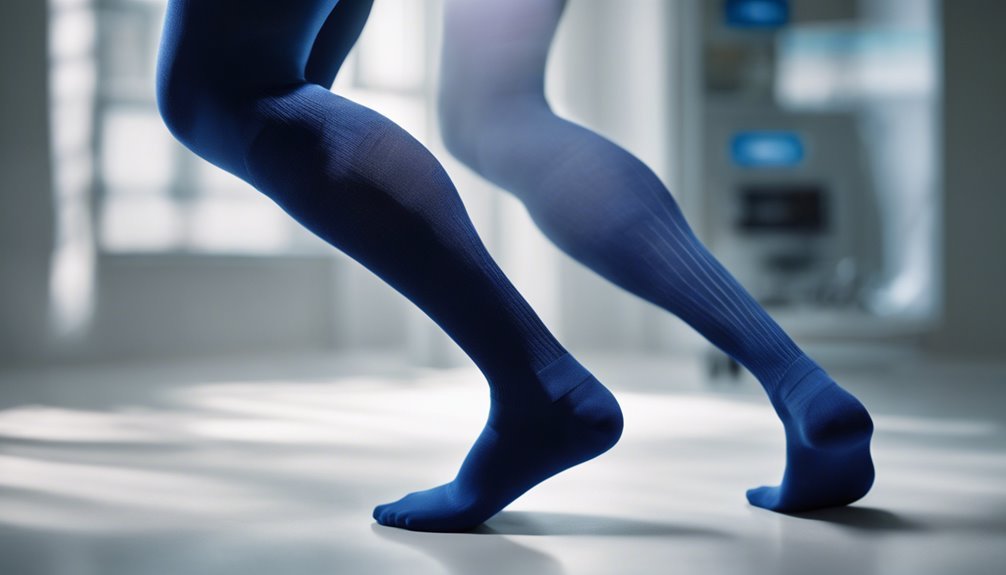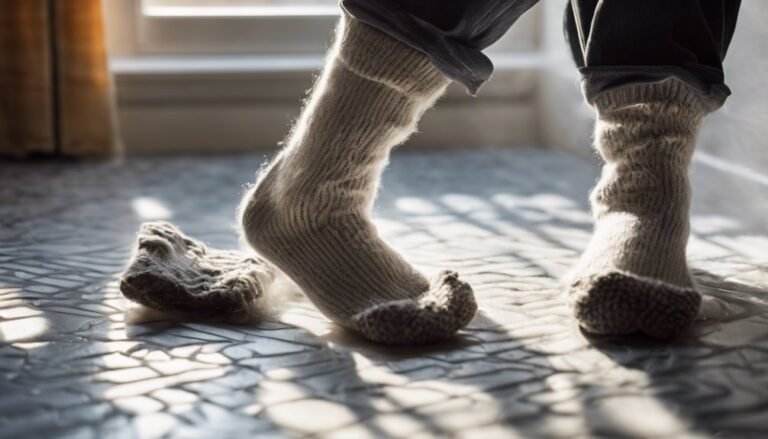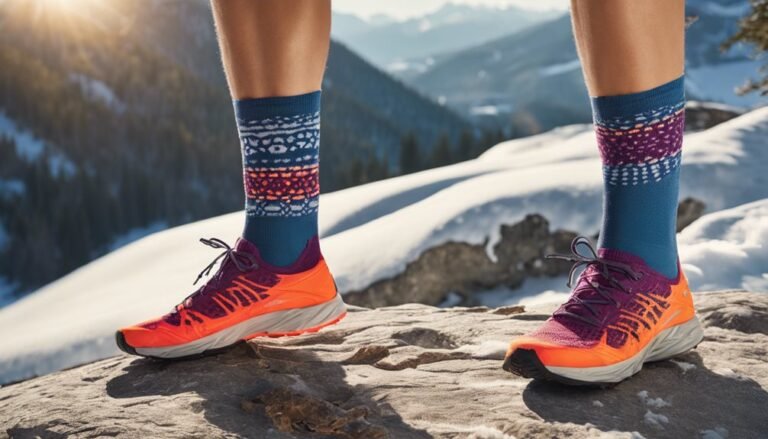Can Socks Actually Improve Circulation? What Research Says
Have you ever noticed how a simple pair of socks can make a world of difference in your day? Imagine slipping on a pair of compression socks before a long flight and feeling surprisingly refreshed when you land.
Compression socks can significantly enhance circulation by applying graduated pressure, boosting venous return, and reducing edema. Research consistently supports their effectiveness, with notable improvements in tissue oxygenation and reduced leg fatigue—essential for ideal mobility and nutrient delivery to cells.
These socks benefit athletes and those needing vascular support, promoting better muscle recovery and preventing circulatory issues. For an in-depth understanding, consult expert recommendations and consider individual health needs for tailored benefits.
Understanding Circulation and Its Importance

Understanding circulation is crucial because it plays an important role in maintaining overall health. Your circulatory system guarantees that blood flow reaches every part of your body, delivering oxygen and nutrients essential for function. When blood flow is unrestricted, it supports peak circulatory health, preventing conditions like peripheral artery disease or venous insufficiency. You want to enjoy freedom from health issues that could limit your lifestyle, so it's imperative to understand how your body works.
Healthy circulation facilitates the removal of waste products, helping maintain your energy levels and overall well-being. When your circulatory health is compromised, symptoms like fatigue, swelling, or numbness can arise, hindering your ability to live freely. Prioritizing circulatory health empowers you to maintain the lifestyle you desire without constraint.
How Compression Socks Are Designed to Work
When you wear compression socks, they apply graduated pressure, which is scientifically proven to enhance venous return and reduce edema. These socks are crafted with specialized materials that balance elasticity and breathability, ensuring ideal comfort throughout your day. By understanding how these elements work together, you can make informed decisions about incorporating compression socks into your health routine.
Graduated Pressure Benefits
Although the concept might seem simple, compression socks are ingeniously designed with graduated pressure to enhance circulation. This strategic design applies maximum pressure at the ankle, gradually decreasing it as the sock extends up your leg. Such a gradient guarantees your blood flows more efficiently back to your heart, reducing the risk of venous disorders.
Research shows that graduated pressure can greatly improve circulation, especially if you're prone to prolonged periods of immobility. By promoting venous return, these socks help minimize swelling and discomfort, granting you the freedom to move with less restriction. When you wear compression socks, you're not just donning a piece of fabric; you're embracing a scientifically-backed method to support your vascular health and enhance overall well-being.
Material and Comfort
Beyond their graduated pressure benefits, compression socks owe their effectiveness to the materials used and their design for comfort. Sock materials, such as nylon, spandex, and polyester, are chosen for their elasticity and durability, ensuring a snug fit that enhances circulation without sacrificing comfort levels. These fabrics work together to manage moisture, reducing the risk of skin irritation and making them suitable for prolonged use.
Research indicates that ideal comfort levels are achieved when compression socks balance pressure and breathability. The seamless construction and targeted cushioning of these socks prevent undue constriction, allowing you the freedom to move without restriction. So, whether you're on a long flight or recovering from exercise, you can trust that these socks are designed with your health and comfort in mind.
The Science Behind Compression Technology

Understanding compression technology requires delving into how these specially designed socks apply graduated pressure to your legs, enhancing venous return and reducing the risk of blood pooling. This pressure gradient aids in optimizing blood flow dynamics, which can be essential for maintaining your vascular health. Compression technology is based on evidence that it can improve circulation efficiency. Here's how it benefits you:
- Pressure Gradient: The socks are tighter at the ankle and gradually loosen toward the knee, promoting upward blood flow.
- Venous Return: Enhanced return of blood to the heart, minimizing venous stasis.
- Reduced Edema: Helps decrease swelling by preventing fluid accumulation.
- Increased Oxygenation: By improving circulation, tissues receive more oxygen, supporting overall vascular well-being.
Embrace the freedom of better blood flow with compression technology.
Exploring the Benefits for Athletes
As an athlete, you're likely aware of the potential benefits of compression socks in optimizing performance by enhancing venous return and oxygen delivery. Evidence suggests that wearing them post-exercise can accelerate muscle recovery and reduce inflammation. Additionally, these socks may play an essential role in preventing muscle fatigue, thereby sustaining your endurance during prolonged physical activity.
Compression Socks Boost Performance
While often considered a simple piece of athletic gear, compression socks play an essential role in enhancing athletic performance by improving blood circulation. By providing graduated pressure, these socks can aid in performance enhancement and athletic recovery by reducing muscle oscillation and fatigue. When you choose to wear compression socks, you're embracing an evidence-based strategy that offers:
- Increased Oxygen Delivery: Enhanced blood flow means more oxygen to muscles, boosting endurance.
- Reduced Muscle Vibration: Stabilizes muscles, minimizing damage during intense activities.
- Decreased Swelling: Alleviates fluid buildup, promoting comfort and mobility.
- Quicker Recovery: Assists in maintaining peak performance levels.
These benefits empower athletes, giving you the freedom to push boundaries and achieve your goals with confidence, knowing your body is supported.
Enhanced Recovery Post-Workout
Compression socks don't just enhance performance during physical activity; they also play a significant role in post-workout recovery. You might be surprised to learn that these specialized garments can facilitate enhanced recovery by promoting efficient blood flow. Evidence suggests that graduated compression can reduce muscle soreness and decrease swelling, making them a crucial component of your post-workout strategies. By improving venous return, these socks optimize oxygen delivery and nutrient replenishment to fatigued muscles, accelerating the body's natural healing processes. For athletes like you, who seek autonomy over their recovery and training regimens, integrating compression socks into your routine offers the potential for quicker recovery times. Embrace this evidence-based approach to maintain peak performance and relish the freedom of a swift recovery.
Preventing Muscle Fatigue
Though often overlooked, preventing muscle fatigue is a critical consideration for athletes aiming for peak performance. When you incorporate compression socks into your regimen, you're not just making a fashion statement; you're enhancing muscle recovery and achieving fatigue reduction. Research indicates that compression gear optimizes blood flow, facilitating efficient oxygen delivery and waste removal. This means less muscle soreness and faster recovery times.
Here's how compression socks can benefit you:
- Enhanced Circulation: Improved venous return boosts muscle oxygenation.
- Reduced Swelling: Compression reduces edema, minimizing muscle strain.
- Increased Endurance: Sustained energy levels allow prolonged activity.
- Accelerated Recovery: Faster toxin clearance aids in quicker muscle recovery.
Diabetic Socks: A Specialized Solution
For individuals managing diabetes, selecting the right socks is fundamental, as diabetic socks offer a specialized solution designed to enhance foot health and improve circulation. These socks are crafted with seamless designs and non-binding tops to aid in diabetic footcare, thereby minimizing the risk of ulcers and pressure points. The moisture-wicking fabric guarantees a dry environment, which is essential for circulation management and reducing infection risk. By emphasizing gentle compression, diabetic socks facilitate blood flow, offering you the freedom to move comfortably and confidently. Additionally, their cushioning provides extra protection, which is indispensable for sensitive feet. When choosing diabetic socks, prioritize materials that enhance circulation without restricting mobility, supporting your lifestyle while guaranteeing peak foot health.
Research Findings on Circulation Improvement

Emerging research underscores the importance of circulation improvement in managing overall health, particularly for individuals with conditions like diabetes. Circulation studies have revealed promising data, with specific research methodologies focusing on the efficacy of compression socks. They can enhance microvascular function, reduce leg edema, and improve venous return. Here's how the findings unfold:
- Enhanced Blood Flow: Studies show increased arterial blood flow, essential for nutrient delivery.
- Decreased Swelling: Compression socks considerably reduce lower limb edema, enhancing comfort.
- Improved Oxygenation: Enhanced tissue oxygenation supports cellular health and vitality.
- Reduced Fatigue: Patients report less leg fatigue, empowering greater mobility and freedom.
These insights offer a compelling narrative for those seeking autonomy in managing circulatory health, empowering you to make informed choices backed by evidence.
Expert Opinions and Recommendations
While the benefits of improved circulation through the use of compression socks are well-documented, it is crucial to take into account expert opinions and recommendations to make personalized, effective decisions. Circulation experts suggest that compression socks can be a valuable tool in managing venous insufficiencies and enhancing peripheral blood flow. However, they emphasize the importance of selecting the right compression level tailored to your specific vascular needs. Expert recommendations often include consulting a healthcare provider to assess your condition thoroughly. You might find that moderate compression is ideal for daily use, while higher levels could be necessary for more severe circulatory issues. Remember, expert guidance guarantees you achieve maximum benefit without compromising comfort or freedom in your daily activities.
Choosing the Right Socks for Your Needs
How do you go about choosing the right socks for your needs when there's a multitude of options available? It's crucial to focus on sock materials and proper fit to enhance circulation. Here's a concise guide:
- Material Composition: Look for socks made from breathable materials like cotton or wool, which support natural thermoregulation and moisture management.
- Compression Levels: Evaluate the compression rating (measured in mmHg) to guarantee ideal blood flow. Lower ratings suit daily wear, while higher ones are for medical conditions.
- Proper Fit: Confirm the socks aren't too tight or loose. Ill-fitting socks can impede circulation.
- Activity Suitability: Choose socks designed for specific activities, whether it's athletic performance or extended sitting.
Frequently Asked Questions
Can Wearing Socks While Sleeping Affect Circulation Negatively?
Think of circulation like a river. If sock thickness is too tight, it could dam the flow, affecting circulation levels. Choose socks that fit well to maintain freedom and support healthy blood flow while sleeping.
Do Different Materials in Socks Impact Blood Flow?
You've wondered if sock materials affect circulation. Compression socks, made of specific fibers, can enhance blood flow, while moisture-wicking materials guarantee comfort. Choosing the right type empowers you to maintain freedom in movement without compromising circulation.
How Do Temperature-Regulating Socks Influence Circulation?
You're curious about temperature-regulating socks, aren't you? They optimize circulation benefits by maintaining thermal balance. Evidence suggests they help manage blood flow, offering potential comfort and freedom for those seeking improved vascular health, enhancing your active lifestyle.
Are There Any Risks Associated With Wearing Tight Socks?
Wearing tight compression socks can restrict blood flow, potentially causing discomfort or skin issues. It's essential to choose a proper fit, ensuring they're snug but not overly tight, to balance circulation benefits with freedom and comfort.
Can Socks Improve Circulation in People With Varicose Veins?
Did you know compression therapy can reduce varicose vein symptoms by up to 70%? Wearing compression socks aids circulation and supports varicose vein prevention, allowing you to maintain your freedom with improved leg health and comfort.







